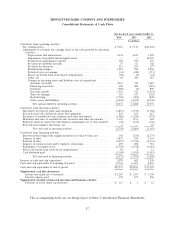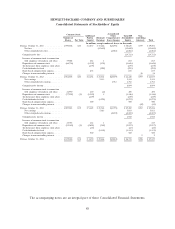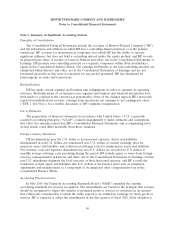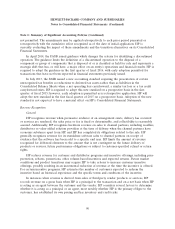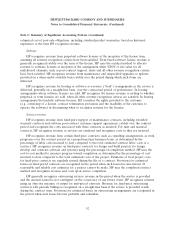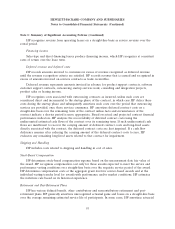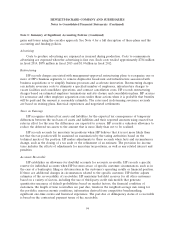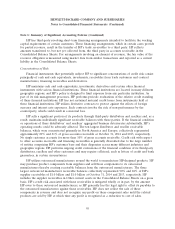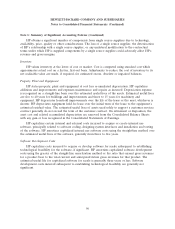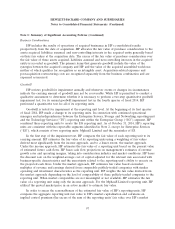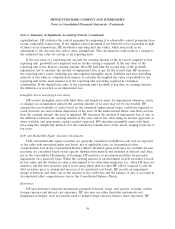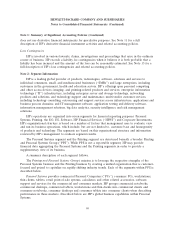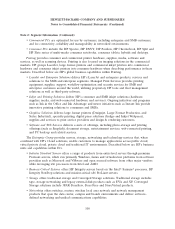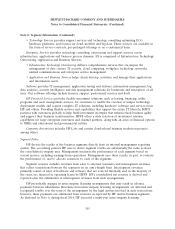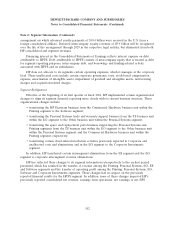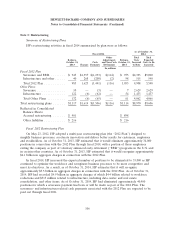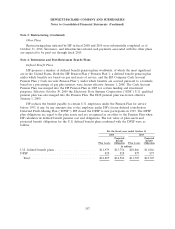HP 2014 Annual Report Download - page 105
Download and view the complete annual report
Please find page 105 of the 2014 HP annual report below. You can navigate through the pages in the report by either clicking on the pages listed below, or by using the keyword search tool below to find specific information within the annual report.HEWLETT-PACKARD COMPANY AND SUBSIDIARIES
Notes to Consolidated Financial Statements (Continued)
Note 1: Summary of Significant Accounting Policies (Continued)
Business Combinations
HP includes the results of operations of acquired businesses in HP’s consolidated results
prospectively from the date of acquisition. HP allocates the fair value of purchase consideration to the
assets acquired, liabilities assumed, and non-controlling interests in the acquired entity generally based
on their fair values at the acquisition date. The excess of the fair value of purchase consideration over
the fair value of these assets acquired, liabilities assumed and non-controlling interests in the acquired
entity is recorded as goodwill. The primary items that generate goodwill include the value of the
synergies between the acquired company and HP and the value of the acquired assembled workforce,
neither of which qualifies for recognition as an intangible asset. Acquisition-related expenses and
post-acquisition restructuring costs are recognized separately from the business combination and are
expensed as incurred.
Goodwill
HP reviews goodwill for impairment annually and whenever events or changes in circumstances
indicate the carrying amount of goodwill may not be recoverable. While HP is permitted to conduct a
qualitative assessment to determine whether it is necessary to perform a two-step quantitative goodwill
impairment test, for its annual goodwill impairment test in the fourth quarter of fiscal 2014, HP
performed a quantitative test for all of its reporting units.
Goodwill is tested for impairment at the reporting unit level. At the beginning of its first quarter
of fiscal 2014, HP made a change to its reporting units. In connection with continued operational
synergies and interdependencies between the Enterprise Servers, Storage and Networking reporting unit
and the Technology Services (‘‘TS’’) reporting unit within the Enterprise Group (‘‘EG’’) segment, HP
combined these reporting units to create the EG reporting unit. As of October 31, 2014, HP’s reporting
units are consistent with the reportable segments identified in Note 2, except for Enterprise Services
(‘‘ES’’), which consists of two reporting units: MphasiS Limited and the remainder of ES.
In the first step of the impairment test, HP compares the fair value of each reporting unit to its
carrying amount. HP estimates the fair value of its reporting units using a weighting of fair values
derived most significantly from the income approach, and to a lesser extent, the market approach.
Under the income approach, HP estimates the fair value of a reporting unit based on the present value
of estimated future cash flows. HP bases cash flow projections on management’s estimates of revenue
growth rates and operating margins, taking into consideration industry and market conditions. HP bases
the discount rate on the weighted-average cost of capital adjusted for the relevant risk associated with
business-specific characteristics and the uncertainty related to the reporting unit’s ability to execute on
the projected cash flows. Under the market approach, HP estimates fair value based on market
multiples of revenue and earnings derived from comparable publicly-traded companies with similar
operating and investment characteristics as the reporting unit. HP weights the fair value derived from
the market approach depending on the level of comparability of these publicly-traded companies to the
reporting unit. When market comparables are not meaningful or not available, HP estimates the fair
value of a reporting unit using only the income approach. For the MphasiS Limited reporting unit, HP
utilized the quoted market price in an active market to estimate fair value.
In order to assess the reasonableness of the estimated fair value of HP’s reporting units, HP
compares the aggregate reporting unit fair value to HP’s market capitalization and calculates an
implied control premium (the excess of the sum of the reporting units’ fair value over HP’s market
97


